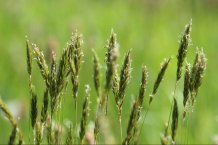Articles

Credit: Simon Creer
Combining public health and environmental science to develop pollen forecasting
New research, which brings healthcare data together with ground-breaking ecological techniques, could set a roadmap for refining pollen forecasts in the future.
Current pollen forecasts, crucial for people with allergic asthma or hay fever to manage their symptoms, rely on measuring the total load of grass pollen in the atmosphere. However, these do not distinguish between pollen from different types of grass.
Now, a potential link between pollen from certain grass species and respiratory health issues has been revealed.
The results, published in Current Biology, (11.3.21DOI: 10.1016/j.cub.2021.02.019 ) have been produced by the first project to use an ecological biomonitoring method called eDNA (‘environmental DNA’) to explore the relationships between airborne pollen and human health. The research led by Bangor and Exeter Universities is part of the larger PollerGEN (Natural Environment Research Council-funded) research project, which in 2019 established the use of eDNA techniques to identify different types of microscopic grass pollen grains.
The current work matched two years of records of public health data (asthma-related hospital admissions, and GP prescribing of respiratory and nasal allergy treatments) with the eDNA monitoring data for pollen from different grass species made at 14 locations throughout the UK.
At certain times of the year, between May and mid-August in temperate zones, grass is the most important hay fever and asthma inducing outdoor airborne allergen.
Prof Simon Creer, of Bangor University, who is leading the PollerGEN research explained:
“This is one first step and theoretical ’proof of concept’ of a vast research project, which could lead to more precise pollen forecast or forecasts for different allergen types.
Worldwide, there are over 400 million people with allergic rhinitis and over 300 million with asthma. Treating allergic asthma costs the UK over £2 million a year in direct costs alone, so there are great potential savings to be made.”
Dr Francis Rowney, who led the health data portion of the work whilst based at the University of Exeter commented:
“Though this is certainly early days, it was fascinating to find that particular grass species may have greater impacts on respiratory health than others.”
“Proteins in the pollen are what trigger allergic reactions, and there are common allergenic proteins between some grass species. We need to better understand the molecular basis of the allergens and allergic reactions to further investigate which are the most allergenic species, and whether there are differences in reactions between different people.”
Dr Georgina Brennan, whilst based at Bangor University’s School of Natural Sciences, was one of a team who pioneered the applications of environmental DNA monitoring.
She explains:
“Pollen grains from different species of grass look almost identical, even under the microscope, and before the advent of eDNA and alongside molecular tools such as metabarcoding and quantitative PCR (qPCR) , it just wasn’t possible to identify grass pollen from different grass species and explore whether different grasses were causing a greater allergenic reaction.
We looked at a range of the most common species at our sites. In this first two-year study, we did find links between the common grasses, Crested Dog’s Tail (Cynosurus cristatus) and Timothy (Phleum pratense), but we would need far more data to be precise about which are the most aggravating grass pollen types. Longer data sets, covering more species and different weather patterns and locations would provide the evidence needed.”
Georgina, who lead the eDNA part of this research, sees a future where a global network of autonomous pollen samplers, able to discriminate and quantify airborne pollen, allows sensitive biomonitoring of important aeroallergens.
“It may be that what we need is not just a total grass pollen count forecast, but also a forecast or forecasts for the most allergenic types of grass pollen as we do for trees and weeds.” she added.
The research paper involved multi-disciplinary working across several institutions. These also included Lund University, the University of Worcester, Aberystwyth University, National Botanic Garden of Wales, Department of Mathematics & Department of Geography, University of Exeter; Allergy UK and The University of Queensland, The Met Office.
Date: 11 March 2021
